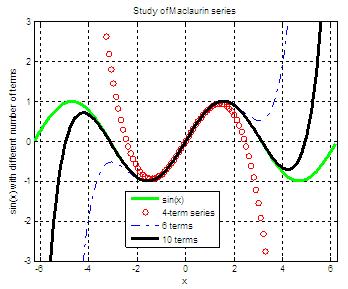

Maclaurin series - some mathematical experiments with Matlab
If you’re approximating a
function value for an x-value far
from 0, you’ll have to use the slightly more
complicated Taylor series,
which work almost exactly like Maclaurin series,
except that you can center them at any x-value. Mathematically, we say
the Maclaurin series approximates
values of f(x) When you work with these
sequences, you’ll actually be
generating Maclaurin polynomials, which are some finite terms of the
series. Before
you start generating the terms to be added, make sure you understand
the
formula. 
The Maclaurin series
generates good approximations of f(x),
as long as As an example, let’s use
the Maclaurin polynomial
(with just
four terms in the series) for the function f(x) = sin(x) to approximate sin(0.1). We first write the terms
of the series from n = 0 to n = 3. 
Definition 1: f(0)(x)
is the function itself. There’s no
derivative. f(0)(x)
= sin(x)
f(0)(0) = sin(0) = 0 clear,
clc %
Let's see more decimals %
We go from n = 0 to n = 3 %
This is the point for evaluation %
These are the derivatives for each term %
We form the sequence, following the formula %
We add-up to get the Maclaurin approximation %
Let's compare with the official number The response is: seq = 0
0.10000000000000
0 -0.00016666666667 We’ve got almost the
exact value by using only 4 terms of
the series (and two
values are zero, because the derivative is zero for
those
terms). If we had used n = 8, it
would have been an even better approximation. Now, let’s develop (code)
an
automated series to express the sine
function (centered at 0) using the Maclaurin expansion and let’s
compare the
results with different number of terms included. function smp =
maclaurin_sin(x, n) % Start
the series with 0 %
Consider all the possible derivatives %
Iterate n times (from 0 to n-1)
% Implement the Maclaurin
expansion
% Find the derivative for the
next term end %
Add-up the calculated terms Note:
the above code is not very efficient, because we’re calculating and
adding
terms even when their derivative is zero, which is a waste of 50% of
the time,
more or less. We’ll leave it as-is just to keep and show the natural
flow of
the formula... Now,
let’s create a script to test and use the function above. clear,
clc, close all %
Work with two full periods %
Plot the goal %
Consider 4 terms %
Consider 6 terms %
Consider 10 terms %
Label the calculated lines The results are:
From 'Maclaurin Series ' to home From 'Maclaurin Series ' to Calculus Problems
|


